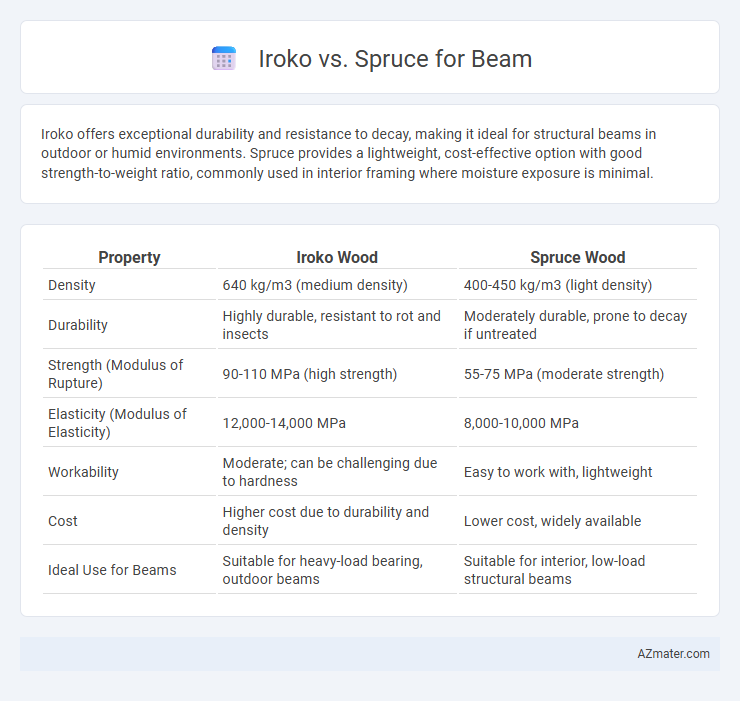Iroko offers exceptional durability and resistance to decay, making it ideal for structural beams in outdoor or humid environments. Spruce provides a lightweight, cost-effective option with good strength-to-weight ratio, commonly used in interior framing where moisture exposure is minimal.
Table of Comparison
| Property | Iroko Wood | Spruce Wood |
|---|---|---|
| Density | 640 kg/m3 (medium density) | 400-450 kg/m3 (light density) |
| Durability | Highly durable, resistant to rot and insects | Moderately durable, prone to decay if untreated |
| Strength (Modulus of Rupture) | 90-110 MPa (high strength) | 55-75 MPa (moderate strength) |
| Elasticity (Modulus of Elasticity) | 12,000-14,000 MPa | 8,000-10,000 MPa |
| Workability | Moderate; can be challenging due to hardness | Easy to work with, lightweight |
| Cost | Higher cost due to durability and density | Lower cost, widely available |
| Ideal Use for Beams | Suitable for heavy-load bearing, outdoor beams | Suitable for interior, low-load structural beams |
Introduction to Iroko and Spruce Wood
Iroko wood, known for its durability and rich golden-brown color, offers exceptional strength and resistance to decay, making it ideal for structural beams in construction. Spruce wood, characterized by its light weight and pale color, is valued for its straight grain and ease of workability, commonly used in framing and indoor beams. Both woods provide unique advantages, with Iroko excelling in outdoor durability while Spruce is preferred for cost-effective, lightweight applications.
Key Characteristics of Iroko Beams
Iroko beams are renowned for their exceptional durability and resistance to decay, making them ideal for structural applications where longevity is critical. The dense, coarse-grained wood offers high stability with minimal warping or shrinking, outperforming spruce in strength and hardness. Iroko's natural oily texture provides inherent water resistance, reducing the need for chemical treatments compared to spruce beams commonly used in indoor, low-exposure environments.
Essential Properties of Spruce Beams
Spruce beams are valued in construction for their excellent strength-to-weight ratio, providing sturdy support while remaining lightweight for easier handling and installation. Their straight grain and uniform texture contribute to dimensional stability and resistance to warping, making spruce an optimal choice for structural applications. With moderate natural durability and good shock resistance, spruce beams ensure reliable performance in framing and roofing.
Strength and Durability Comparison
Iroko wood offers superior strength and durability compared to spruce, making it an excellent choice for structural beams subject to heavy loads and harsh environmental conditions. With a higher density of approximately 850 kg/m3 and exceptional resistance to decay and insect attack, Iroko beams provide long-lasting performance in both interior and exterior applications. Spruce, although lighter with a density around 400 kg/m3, is less durable and more prone to moisture damage, requiring additional treatment when used in load-bearing structures exposed to the elements.
Resistance to Decay and Insect Attack
Iroko wood exhibits exceptional resistance to decay and insect attacks due to its natural oils and dense grain, making it highly durable for structural beams in outdoor and humid environments. Spruce, while lighter and easier to work with, requires chemical treatment to achieve comparable protection against rot and pests. The inherent durability of iroko reduces maintenance needs and extends the lifespan of beams in demanding conditions.
Weight and Workability Factors
Iroko weighs approximately 850 kg/m3, making it significantly denser and heavier than spruce, which has a density around 450 kg/m3, impacting handling and transportation. Spruce offers superior workability due to its softer grain, allowing easier cutting, shaping, and fastening, ideal for detailed carpentry and quick project execution. In contrast, Iroko's hardness and density provide greater durability and resistance to wear but require more effort and specialized tools for machining and installation.
Aesthetic and Visual Appeal
Iroko wood features a rich golden to medium brown hue that deepens with age, offering a warm, luxurious aesthetic ideal for beams in traditional and modern settings. Spruce provides a lighter, pale color with a straight grain and subtle texture, creating a clean, minimalist visual appeal suited for contemporary or rustic beams. The natural color variation and tight grain of Iroko enhance the visual depth and sophistication, while Spruce's uniformity supports bright, airy spaces with a natural wood charm.
Cost and Availability Analysis
Iroko wood commands a higher price due to its durability and hardwood classification, whereas spruce is more cost-effective and widely available, favored for economical beam construction. Availability of iroko is limited to tropical regions and often requires importation, increasing lead times and overall project costs; spruce, being abundant in North America and Europe, ensures faster procurement and consistent supply. Cost considerations favor spruce for budget-sensitive projects, while iroko's price premium may be justified by its superior resistance to decay and insects in structural beam applications.
Sustainable Sourcing and Environmental Impact
Iroko wood, sourced primarily from West Africa, offers a durable and dense alternative to traditional hardwoods with certification options under FSC that promote sustainable forest management. Spruce, commonly found in northern Europe and North America, benefits from faster growth rates and widespread reforestation programs, reducing carbon footprint and ensuring renewable supply for beam construction. The environmental impact of using iroko involves longer growth cycles and potential overharvesting concerns, while spruce's lower embodied energy and improved carbon sequestration capacity support greener building practices.
Best Applications: Choosing the Right Wood for Beams
Iroko wood is best suited for outdoor beams due to its high resistance to moisture, decay, and insects, making it ideal for structural elements exposed to weather. Spruce, being lighter and easier to work with, is typically chosen for indoor beams where strength and stability are essential but moisture exposure is limited. Selecting Iroko or Spruce depends on the environmental conditions and load requirements, with Iroko favored for durability in harsh climates and Spruce preferred for cost-effective indoor framing.

Infographic: Iroko vs Spruce for Beam
 azmater.com
azmater.com